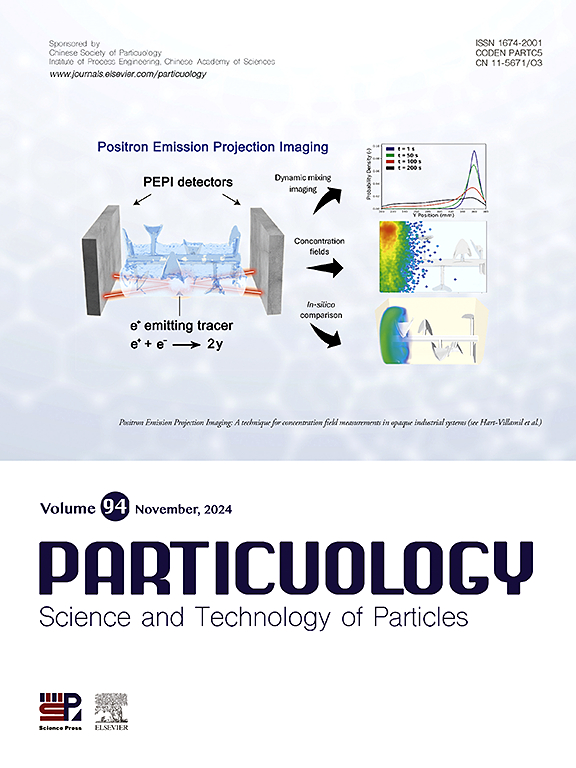Optimizing rice bran ball milling via a friction-coupled population balance model: Integrating comminution theory and energy efficiency
IF 4.3
2区 材料科学
Q2 ENGINEERING, CHEMICAL
引用次数: 0
Abstract
Despite rice bran's considerable nutritional and functional potential, its fibrous structure and high oil content complicate efforts to produce uniform, finely milled powders for food and nutraceutical applications. This study addresses that challenge by examining how milling time (30–90 min) and rotational speed (30–120 rpm) influence both the extent of particle size reduction and the associated energy demand. A laboratory ball mill was used to generate a broad range of operating conditions, while mechanical energy usage and particle-size parameters (d10, d50, d90) were recorded. Population Balance Modeling (PBM) served as the primary analytical framework, calibrated through experimental size distributions to yield breakage kinetics. Frictional effects were incorporated to determine net breakage energy, and classical comminution laws (Bond, Rittinger, Kick) were also evaluated for benchmarking. Results revealed two key milling regimes: an early stage with rapid fragmentation of larger particles, followed by a fine-dominated phase marked by diminished breakage rates and agglomeration. Friction-coupled PBM simulations achieved near-unity parity with experimental data, significantly improving upon simplistic energy models. Short, high-speed milling (e.g., 30 min at 120 rpm) delivered moderate fineness (d50 ≈ 70–90 μm) at relatively low energy (≈0.002–0.005 kWh/ton), whereas prolonged milling (≥90 min) could push median sizes below 5 μm but escalated energy consumption (∼5 kWh/ton). These findings highlight the trade-off between achieving ultra-fine bran and managing rising power costs. By integrating friction-coupled PBM insights with empirical measurements, the study provides a rigorous basis for multi-objective process optimization, guiding industrial-scale rice bran milling toward both enhanced product quality and improved energy efficiency.

基于摩擦耦合种群平衡模型的米糠球磨优化:结合粉碎理论与能源效率
尽管米糠具有相当大的营养和功能潜力,但其纤维结构和高含油量使生产用于食品和营养保健应用的均匀,精细研磨的粉末复杂化。本研究通过考察磨矿时间(30-90分钟)和转速(30-120转/分)对颗粒尺寸减小程度和相关能源需求的影响,解决了这一挑战。使用实验室球磨机来产生广泛的操作条件,同时记录机械能使用和粒度参数(d10, d50, d90)。种群平衡模型(PBM)作为主要的分析框架,通过实验尺寸分布来校准产量断裂动力学。摩擦效应被纳入确定净破碎能量,经典粉碎定律(Bond, Rittinger, Kick)也被评估为基准。结果揭示了两个关键的铣削制度:早期阶段,大颗粒的快速破碎,其次是一个细主导阶段,以减少破碎率和团聚为标志。摩擦耦合PBM模拟与实验数据接近一致,显著改进了简单的能量模型。短时间高速铣削(例如,在120转/分钟下,30分钟)以相对较低的能量(≈0.002-0.005千瓦时/吨)提供中等细度(d50≈70-90 μm),而长时间铣削(≥90分钟)可以将中值尺寸推至5 μm以下,但会增加能耗(约5千瓦时/吨)。这些发现强调了实现超细麸皮和管理不断上升的电力成本之间的权衡。通过将摩擦耦合PBM见解与实证测量相结合,该研究为多目标流程优化提供了严格的基础,指导工业规模米糠碾磨朝着提高产品质量和提高能源效率的方向发展。
本文章由计算机程序翻译,如有差异,请以英文原文为准。
求助全文
约1分钟内获得全文
求助全文
来源期刊

Particuology
工程技术-材料科学:综合
CiteScore
6.70
自引率
2.90%
发文量
1730
审稿时长
32 days
期刊介绍:
The word ‘particuology’ was coined to parallel the discipline for the science and technology of particles.
Particuology is an interdisciplinary journal that publishes frontier research articles and critical reviews on the discovery, formulation and engineering of particulate materials, processes and systems. It especially welcomes contributions utilising advanced theoretical, modelling and measurement methods to enable the discovery and creation of new particulate materials, and the manufacturing of functional particulate-based products, such as sensors.
Papers are handled by Thematic Editors who oversee contributions from specific subject fields. These fields are classified into: Particle Synthesis and Modification; Particle Characterization and Measurement; Granular Systems and Bulk Solids Technology; Fluidization and Particle-Fluid Systems; Aerosols; and Applications of Particle Technology.
Key topics concerning the creation and processing of particulates include:
-Modelling and simulation of particle formation, collective behaviour of particles and systems for particle production over a broad spectrum of length scales
-Mining of experimental data for particle synthesis and surface properties to facilitate the creation of new materials and processes
-Particle design and preparation including controlled response and sensing functionalities in formation, delivery systems and biological systems, etc.
-Experimental and computational methods for visualization and analysis of particulate system.
These topics are broadly relevant to the production of materials, pharmaceuticals and food, and to the conversion of energy resources to fuels and protection of the environment.
 求助内容:
求助内容: 应助结果提醒方式:
应助结果提醒方式:


